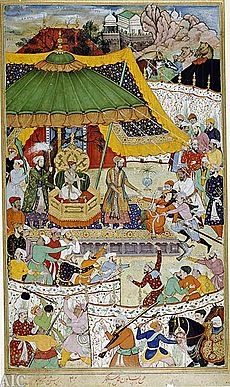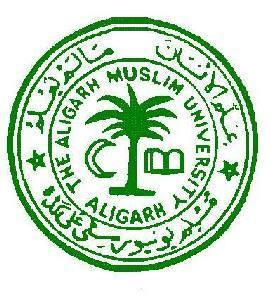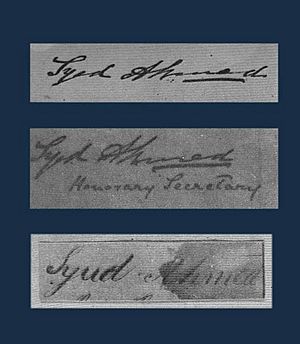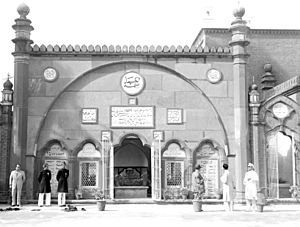Syed Ahmad Khan facts for kids
Quick facts for kids
Syed Ahmed Khan
|
|
|---|---|
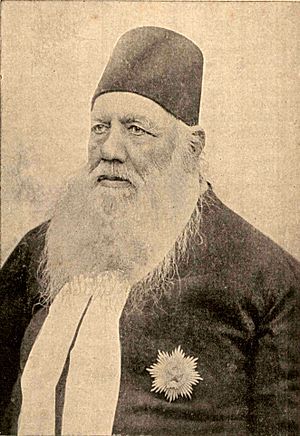 |
|
| Born | 17 October 1817 |
| Died | 27 March 1898 (aged 80) Aligarh, North-Western Provinces, British India
|
| Other names | Sir Syed |
|
Notable work
|
The Mohammadan Commentary on the Holy Quran (tafsir on Quran). |
| Awards | |
| Era | 19th-century |
| School | Islamic and Renaissance philosophy |
| Institutions | East India Company Indian Judicial Branch Aligarh Muslim University Punjab University Government College University |
|
Main interests
|
Pragmatism, metaphysics, language, aesthetics, Christianity and Islam |
|
Notable ideas
|
Two-nation theory, Muslim adoption of Western ideas |
|
Influences
|
|
|
Influenced
|
|
| Signature | |
Sir Syed Ahmad Khan (17 October 1817 – 27 March 1898) was an important Indian Muslim leader. He was a philosopher and worked to improve education in British India during the 1800s. He believed that Muslims needed to learn modern science and Western ideas to succeed.
Syed Ahmad Khan started many schools and journals. He is also known for his idea that Muslims in India were a separate nation. This idea later helped lead to the creation of Pakistan. He was given an honorary degree from the University of Edinburgh in 1889.
In 1838, Syed Ahmad Khan began working for the East India Company. He became a judge in 1867 and retired in 1876. During the Indian Mutiny of 1857, he stayed loyal to the British. He even helped save European lives. After the rebellion, he wrote a book called The Causes of the Indian Mutiny. In it, he bravely criticized British policies that he felt caused the revolt.
Syed Ahmad Khan believed that Muslims needed to change their old ways of thinking. He encouraged them to adopt Western-style scientific education. He founded modern schools and journals to help with this. He also organized Muslim business people.
In 1859, he opened Gulshan School in Muradabad. He started Victoria School in Ghazipur in 1863. He also created a scientific society for Muslims in 1863. In 1875, he founded the Muhammadan Anglo-Oriental College. This was the first Muslim university in Southern Asia. Throughout his life, Syed Ahmad Khan asked Muslims to be loyal to the British. He also promoted Urdu as the main language for all Indian Muslims. He disagreed with the Indian National Congress.
Sir Syed Ahmad Khan is still remembered in Pakistan and by Indian Muslims. He greatly influenced other Muslim leaders like Allama Iqbal and Muhammad Ali Jinnah. His ideas about connecting Islam with science and modern thinking still inspire people today. Many universities and buildings in Pakistan are named after him.
Aligarh Muslim University celebrated his 200th birthday on 17 October 2017. The former President of India Pranab Mukherjee was the main guest.
Contents
Early Life and Family
Syed Ahmad Taqvi 'Khan Bahadur' was born on 17 October 1817. His parents were Syed Muhammad Muttaqi and Aziz-un-Nisa. He was born in Delhi, which was the capital of the Mughal Empire at that time. His family had strong connections to the Mughal court for many generations.
His maternal grandfather, Khwaja Fariduddin, was a Wazir (a high-ranking minister) in the court of Emperor Akbar Shah II. His paternal grandfather, Syed Hadi Jawwad, held an important administrative position. Sir Syed's father, Syed Muhammad Muttaqi, was a personal adviser to Emperor Akbar Shah II. However, Syed Ahmad Khan was born when the Mughal Empire was losing power. The East India Company was becoming more powerful.
Syed Ahmad was the youngest of three children. He had an elder brother, Syed Muhammad, and an elder sister, Safiyatun Nisa. They grew up in their maternal grandfather's home. They followed strict Mughal noble traditions and learned about politics. His mother, Aziz-un-Nisa, was very important in his early life. She raised him with strong discipline and believed in modern education.
Education and Learning
Syed Ahmad Khan's education started in 1822 with Shah Ghulam Ali. He learned to read the Qur'an from a female teacher. He received a traditional education for Muslim nobles in Delhi. He went to a school called a maktab. There, he learned Persian and Arabic.
He read books by famous Muslim scholars and writers. These included Sahbai, Zauq, and Ghalib. Other teachers taught him mathematics, astronomy, and algebra. He also studied medicine for several years. Sir Syed was also good at swimming, shooting, and other sports. He took part in cultural events at the Mughal court.
His elder brother started a weekly newspaper called “Syedul Akhbar”. It was one of the first Urdu newspapers in North India. Until his father died in 1838, Sir Syed lived like a wealthy young Muslim noble. After his father's death, he inherited his family's titles. The emperor Bahadur Shah Zafar gave him the title Arif Jung. Financial problems stopped his formal education. However, he continued to study many subjects on his own.
Career in Government Service
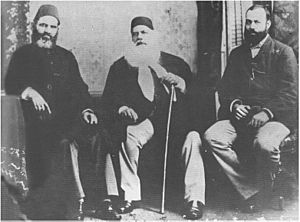
Sir Syed saw that the Mughal Empire was losing power. So, he decided to work for the East India Company. He could not join the top colonial civil service at first. This was because Indians were not allowed until the 1860s. His first job was a Serestadar (clerk) in Delhi. He was in charge of keeping records and managing court matters.
In 1839, he moved to Agra and was promoted. In 1841, he became a Munsif (Sub-Judge) in Fatehpur Sikri. He later moved to Delhi in 1846. In 1855, he was promoted to Sadr Amin in Bijnor.
Working in the courts, Sir Syed learned a lot about British politics. When the Indian rebellion started in 1857, he was in Bijnor. He stayed loyal to the British officers there. He saved the lives of many officers and their families. The conflict caused many deaths. Important Muslim cities like Delhi and Lucknow were badly affected. He lost several close relatives in the violence. He managed to rescue his mother, but she died later due to the hardships.
In 1858, he became Sadarus Sudoor in Muradabad. There, he started writing his famous book, The Cause of the Indian Revolt. He was later transferred to Ghazipur in 1862 and Aligarh in 1864. In 1864, he moved to Banaras and became a Sub-Judge.
In 1869, he went to England with his two sons. His son Syed Mahmood had received a scholarship to study there.
Sir Syed retired from government service in 1876. He settled in Aligarh. From 1878 to 1883, he was a member of the Imperial Legislative Council. He also served the Legislative Council of the North-Western Provinces from 1887 to 1893.
Key Influences on Sir Syed
Sir Syed's mother, Aziz-un-Nisa, and maternal grandfather, Khwaja Fariduddin, greatly influenced him. His grandfather was a minister, teacher, mathematician, and astronomer. He was also interested in Sufism, which affected Sir Syed from a young age. His maternal uncle, Khwaja Zainuddin Ahmad, who was good at music and mathematics, also influenced him.
In Delhi, he met famous writers like Ghalib and Zauq. Their beautiful writing style influenced his own. He also visited Imam Baksh Sahbai and Sadruddin Khan Azurda Dehlawi. His teacher and friend in Agra, Nur al Hasan, also helped him with his early writings.
He was also influenced by the Tunisian reformer Hayreddin Pasha. He learned from Pasha's idea of using freedom of expression to bring changes to the Muslim community.
Western writers like John Stuart Mill influenced his political ideas. He often quoted Mill's works. He also liked the essays of Joseph Addison and Richard Steele. He used their journals, Tatler and Spectator, as models for his own.
Important Writings
Sir Syed started writing at age 23, in 1840. He wrote about many topics, from mechanics to education, mostly in Urdu. He wrote at least 6,000 pages. He also wrote a well-known book on archaeology called Athar-ul-Sandeed. He became interested in literature after meeting famous Indian writers.
Religious Writings
Sir Syed Ahmad Khan began his writing career in 1842. He published several books in Urdu about religious topics. At first, his religious ideas were traditional. But they became more independent as he learned about Western ideas. His early works showed the influence of Sufism and his Delhi upbringing.
These early writings focused on promoting the practices of the Islamic prophet Muhammad. He wanted to reform Indian Muslims from new religious practices. He aimed to bring back the pure Islamic belief in India.
His later religious writings included comments on the Torah and Gospel. He also wrote essays on Muhammad. These were written to respond to Christian missionaries in India. They also addressed the harsh views of British historians towards Islam.
Early Books
His first book in 1842 was about Muhammad. It was called Jila al- Qulub bi Zikr al-Mahbub. It was written to be read aloud during Mawlid celebrations. In 1844, he published Tuhfa-i Hasan. This was an Urdu translation of parts of Shah Abdul Aziz Dehlavi's book. It criticized Shia beliefs.
His third book, Kalimat al-Haqq, came out in 1849. It criticized common Sufi practices. He argued that Muhammad is the only true spiritual guide. He called for changes in how people followed Sufi leaders. In 1850, he published Rah i Sunna dar radd i Bid'a. In this book, he disagreed with religious practices that he felt were new and not part of the true Sunnah. In 1852, he defended the Sufi practice of visualizing one's spiritual guide. In 1853, he translated parts of al-Ghazali's Kimiya al Sa'ada.
Essays on the Life of Muhammad
In 1869, he wrote Al-Khutbat al-Ahmadiya. This book was a response to William Muir's book, The Life of Mahomet, published in 1864. Sir Syed was very upset by Muir's description of Islam and Muhammad. He worried that Muir's book might make young Muslims doubt their faith. To prepare for his book, he went to England with his son. He wanted to see Western civilization for himself.
He also read Darwin's works. While he didn't agree with everything, he believed in a form of theistic evolution. He found support for this idea in his own research and in the writings of earlier Islamic scholars.
Tafsir-ul-Quran
Sir Syed started writing a tafsir (commentary) on the Quran in 1877. It was published as Tafsir ul-Quran in seven volumes. The first volume came out in 1880. The last volume was published in 1904, after his death. In this work, he explained 16 parts and 13 chapters of the Quran. He also included a detailed article on the principles of commentary.
Historical Writings
Sir Syed loved studying history. In 1840, he created a book of dates about the Timurid rulers of Delhi. This was later published as Jam-i-Jum. In Silsilat-ul-Mulk, he collected information about all the rulers of Delhi. He also wrote a history of Bijnor, but it was lost during the 1857 rebellion.
He also edited important historical books. These included Ziauddin Barani's Tarikh-e-Firoz Shahi (1862) and Tuzk-e-Jahangiri (1864). But his most famous historical works were the two editions of Asar-us-Sanadid and Ain-e-Akbari.
Asar-us-Sanadid
In 1847, he published Asar-us-Sanadid (The Remnants of Ancient Heroes). This book described old buildings and monuments in Delhi from the medieval period. It had four parts. It described buildings outside Delhi, around Delhi Fort, and in Shahjahanabad. The last part gave a brief history of Delhi's settlements and famous people. These people included Sufis, doctors, scholars, poets, and musicians.
The book also had about 130 illustrations. These were the first lithographically produced book illustrations in India. He released a second edition in 1854. This second edition was shorter and more factual. This work made Sir Syed famous as a cultured scholar. In 1861, it was translated into French. The book was also given to the Royal Asiatic Society of Great Britain and Ireland, which made him an honorary member.
Ain-e-Akbari
In 1855, he finished his detailed edition of Abul Fazl's Ai'n-e Akbari. The first and third volumes were published in 1855. The second volume was lost in the 1857 rebellion.
After finishing his work, Sir Syed asked Mirza Asadullah Khan Ghalib to write a foreword. Ghalib wrote a short Persian poem. It criticized the Ai'n-e Akbari and the old Mughal culture it represented. Ghalib said the book had little value. He praised the "sahibs of England" instead.
After this, Sir Syed never wrote another word praising the Ai'n-e Akbari. He stopped actively working on history and archaeology. He did edit two more historical texts, but they were not like the Ai'n-e Akbari.
Political Writings
During the 1857 uprising, Sir Syed was in Bijnor. He wrote about the rebellion in Tarikh i Sarkashi-ye Bijnor (1858). He was very worried about what the rebellion would mean for Muslims. He wrote many articles and pamphlets to defend Muslims and Islam. He wanted to create good relations between the British and the Muslim community. These writings included Asbab-e-Baghawat-e-Hind (The Causes of the Indian Revolt) and Loyal Muhammadans of India.
Causes of the Indian Revolt
Sir Syed supported the East India Company during the 1857 uprising. In 1859, he published Asbab-e-Baghawat-e-Hind in Urdu. In this book, he explored the reasons for the Indian revolt. He disagreed with the idea that Muslim leaders planned the rebellion. He blamed the East India Company for its aggressive expansion. He also blamed British politicians for not understanding Indian culture. Sir Syed advised the British to appoint Muslims to help with administration. He believed this would prevent future rebellions.
He sent almost all 500 copies of his pamphlet to England. One copy went to the government. When the government translated the book, some officials criticized it. But Lord Canning, the governor-general, accepted it as an honest report. Later, a British official named Cecil Beadon called it "an extremely seditious pamphlet." He wanted Sir Syed to be punished. But other council members disagreed.
Sir Syed later met Beadon. He explained that he had only printed 500 copies. Most were sent to England, and he had the rest. He said he wanted to help both the rulers and the people of India. Beadon was convinced and later became one of Sir Syed's strongest supporters.
Many official translations of The Causes of the Indian Revolt were made. A translation by Sir Syed's friend, Colonel G.F.I. Graham, was published in 1873.
Loyal Muhammadans of India
In 1860, Sir Syed wrote a series of pamphlets called Risala Khair Khwahan-e Musalmanan-e-Hind. These pamphlets told stories of Muslims who supported the British during the 1857 uprising. The first two parts came out in 1860, and the third in 1861. The first part showed the bravery of loyal Muslims. The second part explained the difference between jihad and rebellion.
Review on Hunter's Indian Musalmans
In 1871, William Wilson Hunter published Indian Musalmans. In this book, he discussed the Indian Wahabi movement. He argued that Muslims were a threat to the British Empire. Hunter linked Wahhabism with rebellion. His accusations led to Muslims being punished in India. Many Muslims felt his arguments were unfair. This led Sir Syed to write a response.
He reviewed the book in The Pioneer newspaper. His articles were later collected and published as a book in England. Sir Syed based his arguments on Muhammad's actions during holy wars.
Muslim Reformer and Educator
By the 1850s, Syed Ahmad Khan became very passionate about education. He studied European law and realized the benefits of Western-style education. This type of education was being offered in new colleges across India. Even though he was a religious Muslim, Sir Syed criticized old religious beliefs. He felt these beliefs made most Indian Muslims suspicious of British ideas.
Sir Syed became more and more worried about the future of Muslim communities. He came from a noble Mughal family. He saw the steady decline of Muslim power in India. The bad feelings between the British and Muslims after the Indian Rebellion of 1857 threatened to harm Muslim communities for many years.
Scientific Society
Sir Syed worked hard to encourage Muslims to cooperate with the British. He promoted loyalty to the Empire among Indian Muslims. He wanted to help Muslims improve their lives. In 1859, he founded a modern madrassa (religious school) in Muradabad. This was one of the first religious schools to teach science.
Sir Syed also helped with social causes. In 1860, he organized help for people affected by famine. In Ghazipur in 1863, he started a madrasa that later became Victoria High School. He also formed the Scientific Society in Ghazipur. This society aimed to promote education reforms across the country. He wrote an important paper on education.
When he moved to Aligarh in 1864, Sir Syed became a full-time educator. The Scientific Society moved from Ghazipur to Aligarh. It was renamed the Scientific Society of Aligarh. Sir Syed gathered Muslim scholars from different parts of India. The Society held yearly meetings. It gave money for education and published a journal on science in English and Urdu. Sir Syed believed that Muslims' future was at risk. This was because they were against modern science and technology. He wrote many articles promoting new ways of understanding Islamic scriptures. He tried to find logical explanations for jinn, angels, and miracles.
For example, he argued that riba (often translated as interest) only referred to interest charged to the poor. He said it did not apply to loans for trade or industry. He believed this type of finance supported "trade, national welfare and prosperity." Many religious scholars said all interest was riba. But Sir Syed argued this was based on their own ideas, not directly from the Quran.
Muhammadan Anglo-Oriental College
On 1 April 1869, he went to England with his sons. He was given the Order of the Star of India by the British government on 6 August. While traveling in England, he visited colleges. He was inspired by the learning culture there. Sir Syed returned to India determined to build a school like Cambridge and Oxford. He wanted it to teach modern education to Indians.
When he came back, he started a committee on 26 December 1870. This committee was for spreading and improving learning among Muslims. By 1872, it became a fund committee to build a school.
He started publishing the journal Tehzeeb-ul-Akhlaq (Social Reformer) on 24 December 1870. This journal aimed to share modern knowledge. It also promoted reforms in Muslim society. Sir Syed worked to reinterpret Muslim ideas. He wanted to connect traditional beliefs with Western education. In his books on Islam, he argued that the Qur'an valued reason and natural law. This made scientific study important for being a good Muslim.
By 1873, Sir Syed's committee proposed building a college in Aligarh. Maulvi Samiullah Khan became the secretary of the school's sub-committee. Committee members traveled to raise money for the school. It finally opened on 24 May 1875 in Aligarh. It was called the Muhammadan Anglo-Oriental Collegiate School. Two years later, in 1877, it became the Muhammadan Anglo-Oriental College.
He retired from his job as a judge the next year. He focused completely on developing the college and religious reform. Sir Syed's important work received support from the British. Some traditional religious leaders criticized him. But Sir Syed's new school attracted many students. Most came from wealthy and middle-class Muslim families. However, MAO College was open to all communities. It had many Hindu students. The first person to graduate from the college was a Hindu.
The college taught science and Western subjects. It also taught Eastern subjects and religious education. The first chancellor was Sultan Shah Jahan Begum, a famous Muslim noblewoman. Sir Syed invited an Englishman, Theodore Beck, to be the first principal. The college was first connected to Calcutta University. But it moved to Allahabad University in 1885. Around 1900, it started its own magazine and a law school. In 1920, the college became Aligarh Muslim University.
Muhammadan Educational Conference
After founding the Anglo-Oriental College, Sir Syed felt a need for a large organization. He wanted it to spread the ideas of his movement across India. So, he established the All India Muhammadan Educational Congress. Its main office was in Aligarh.
The first meeting of the Congress was held in Aligarh in 1886. Its main goal was to promote education among Muslims. It did this through conferences across India. It also aimed to turn the Anglo-Oriental College into a university. The organization's name was later changed to All India Muhammadan Educational Conference. This was to avoid confusion with the Indian National Congress.
Political Ideas and Actions
Sir Syed was mainly an educator and reformer, not just a political thinker. His political ideas were shaped by events of his time. These included the 1857 Rebellion and the leadership of William Ewart Gladstone in England. The rule of Lord Ripon in India also influenced him.
Sir Syed was very religious. His political views were based on Islam.
In 1878, Sir Syed was chosen to be part of the Viceroy's Legislative Council. He spoke before the education commission. He promoted building more colleges and schools across India. At first, Sir Syed supported Hindu–Muslim unity. He wanted to empower all Indians. In the same year, he founded the Muhammadan Association. This group aimed to promote political cooperation among Indian Muslims. In 1886, he organized the All India Muhammadan Educational Conference. This conference promoted his ideas for modern education and Muslim political unity. His work made him the most important Muslim politician in 19th-century India. He often influenced how Muslims felt about national issues.
Against Active Politics
Sir Syed did not encourage Muslims to be very active in politics. He believed that getting a good English education was the most important thing for Muslims. He thought this was more important than political activities. He did not support the National Muhammadan Association. This was a political group founded by Syed Ameer Ali in 1887. He also refused to join the Muhammedan National Conference. He saw it as a political protest.
When the Indian National Congress was formed in 1885, he didn't say anything at first. But later, he became a strong critic of the organization.
Sir Syed's opposition was criticized by some. Lala Lajpat Rai wrote open letters expressing surprise at his change in attitude towards Congress.
Sir Syed believed in using official ways to express problems to the British government. He supported Surendranath Banerjee and Dadabhai Naoroji. These Indian leaders wanted Indians to have more representation in government jobs. In 1883, he started the Muhammadan Civil Service Fund Association. This group encouraged Muslims to join the Indian Civil Service (ICS). In 1883, he created the Muhammedan Association. This group presented Muslim concerns to the Imperial Legislative Council. In 1887, Lord Dufferin appointed him to the Civil Service Commission. In 1888, he and Raja Shiv Prasad started the United Patriotic Association. This group aimed to promote cooperation with the British. It also encouraged Muslim participation in the British government.
Hindu–Muslim Unity Views
Early in his career, Syed Ahmad Khan supported Hindu–Muslim unity in India. He famously said: "India is a beautiful bride and Hindus and Muslims are her two eyes. If one of them is lost, this beautiful bride will become ugly." He grew up in Delhi, a city with both Hindu and Muslim festivals. He collected Hindu religious books. He was friends with Swami Vivekanand and Debendranath Tagore. In the 1800s, he was against killing cows. He even stopped a Muslim friend from sacrificing a cow for Eid al-Adha. He did this to promote peace between Muslims and Hindus.
When he founded Muhammadan Anglo-Oriental College, he allowed students of all faiths. Its first principal was a Christian, and one of its supporters was a Sikh. Shafey Kidwai notes that Sir Syed promoted "the empowerment of all Indians."
However, in his book Causes of the Indian Revolt (1858), he called Hindus and Muslims 'two antagonistic races'. He said it was a British mistake to bring them together.
Supporting Urdu Language
The Hindi–Urdu controversy began in 1867. Sir Syed became a strong supporter of the Urdu language. He was a leading Muslim voice against making Hindi a second official language. This was in the United Provinces (now Uttar Pradesh). Sir Syed saw Urdu as the common language of the United Provinces. He believed it was a mix of Muslim and Hindu contributions.
Urdu developed during the Mughal period. It was used as a second language to Persian, the official language. After the Mughal Empire declined, Sir Syed promoted Urdu through his own writings. Under Sir Syed, the Scientific Society translated Western books only into Urdu. The schools he started taught in Urdu. The demand for Hindi, mostly by Hindus, seemed to Sir Syed like an attack on Muslim culture in India. When he spoke to the British education commission, he controversially said that "Urdu was the language of upper class and Hindi that of the vulgar." His comments angered Hindu leaders. They united to demand that Hindi be recognized.
The success of the Hindi movement made Sir Syed support Urdu even more. He saw it as a symbol of Muslim heritage and the language of all Indian Muslims. His educational and political work became more focused on Muslim interests. He also tried to convince the British to use Urdu widely in official settings. His colleagues, like Mohsin-ul-Mulk and Maulvi Abdul Haq, created groups like the Urdu Defence Association. These groups worked to keep Urdu alive. Their efforts led to Urdu becoming the official language of the Hyderabad State. It also became the language of teaching at Osmania University. For Muslims in northern and western India, Urdu became a key part of their identity. However, the disagreement over Hindi or Urdu increased conflicts between Muslims and Hindus.
Two-Nation Theory Idea
Sir Syed is seen as the first person to suggest the idea of separate nationhood for Muslims in India. In a speech in Meerut in 1866, he described Muslims and Hindus as two separate nations. He is considered the father of the two-nation theory. This idea led to the partition of India.
The Urdu-Hindi controversy is seen as a turning point in Sir Syed's views. He expressed his ideas about Muslim nationhood in his later speeches.
Personal Life
In 1836, he married Parsa Begum. They had two sons, Syed Hamid and Syed Mahmood. They also had a daughter, Ameena, who died young.
Sir Syed Ahmad Khan Bahadur spent the last 20 years of his life in Aligarh. He was widely seen as a mentor for Muslim leaders in the 19th and 20th centuries. He died on 27 March 1898, after battling illnesses and old age. He was buried in Sir Syed Masjid on the campus of Aligarh Muslim University.
Legacy and Influence
Syed Ahmad Khan is widely remembered in South Asia. He is seen as a great Muslim social reformer and visionary. His ideas about education and his modern thinking inspired Muslim leaders. These leaders supported the All India Muslim League. In 1886, he founded the All India Muhammadan Educational Conference. Its goal was to promote Western education, especially science and literature, among Indian Muslims.
This conference raised money for Ahmad Khan's Muhammadan Anglo-Oriental College. It also encouraged Muslim leaders to expand educational efforts elsewhere. This movement became known as the Aligarh Movement. This new awareness of Muslim needs helped create a political awareness among Muslim leaders. This awareness later led to the formation of the AIML. This group then led Muslims in India towards the creation of Pakistan.
He influenced many political leaders, thinkers, and writers. These included Muhammad Iqbal, Abul Kalam Azad, Sayyid Mumtaz Ali, Altaf Hussain Hali, Shibli Nomani, Nawab Mohsin-ul-Mulk, Chiragh Ali, and Nazir Ahmad Dehlvi.
The university he founded is still one of India's most important institutions. It was a key place for Muslim India. Famous graduates of Aligarh include Muslim political leaders like Maulana Mohammad Ali Jouhar and Abdur Rab Nishtar. The first two Prime Ministers of Pakistan, Liaquat Ali Khan and Khawaja Nazimuddin, also graduated from Aligarh. Indian President Dr. Zakir Hussain is another famous graduate. His birthday is celebrated as Sir Syed Day every year by the university and its alumni.
Several educational institutions in India and Pakistan are named after him. These include Sir Syed University of Engineering and Technology and Sir Syed College, Taliparamba.
Honors and Recognition
On 2 June 1869, Syed Ahmad Khan was made a Companion of the Order of the Star of India (CSI). This was for his service as Principal Sadr Amin. He was also made a fellow of Calcutta and Allahabad Universities in 1876 and 1887.
Syed Ahmad was later given the title 'Khan Bahadur'. In 1888, the British government made him a knight. He became a Knight Commander of the Order of the Star of India (KCSI). This was for his loyalty to the British crown and his work on the Imperial Legislative Council. The next year, he received an honorary LL.D. degree from Edinburgh University.
India Post issued postage stamps in his honor in 1973 and 1998.
Pakistan Postal Services also issued a postage stamp in his honor in 1990. It was part of their 'Pioneers of Freedom' series.
In 1997, Syed Ahmad Khan was honored with an English Heritage blue plaque. It was placed at 21 Mecklenburgh Square in Bloomsbury, London. He lived there in 1869–70.
In 2017, a special Rs. 50 coin featuring Sir Syed Ahmad Khan was released. This was for his 200th birth anniversary.
On 14 August 2022, the State Bank of Pakistan revealed a special Rs.75 note. It featured Syed Ahmed Khan and other founding fathers. This marked Pakistan's diamond jubilee celebrations.
Images for kids
See also
 In Spanish: Syed Ahmed Khan para niños
In Spanish: Syed Ahmed Khan para niños
- Tafazzul Husain Kashmiri
- Aligarh Muslim University
- Aligarh Movement
- All India Muhammadan Educational Conference
- Two-nation theory
- Muslim nationalism in South Asia
- All India Muslim League
- Islamic Modernism



